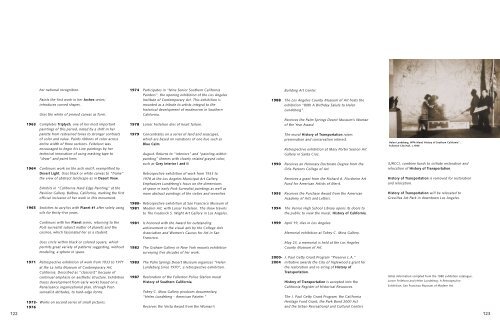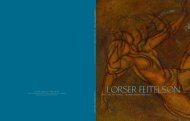helen lundeberg - Louis Stern Fine Arts
helen lundeberg - Louis Stern Fine Arts
helen lundeberg - Louis Stern Fine Arts
You also want an ePaper? Increase the reach of your titles
YUMPU automatically turns print PDFs into web optimized ePapers that Google loves.
her national recognition.<br />
Paints the first work in her Arches series;<br />
introduces curved shapes.<br />
Uses the white of primed canvas as form.<br />
1963 Completes Triptych, one of her most important<br />
paintings of this period, noted by a shift in her<br />
palette from restrained tones to stronger contrasts<br />
of color and value. Paints ribbons of color across<br />
entire width of three sections. Feitelson was<br />
encouraged to begin his Line paintings by her<br />
technical innovation of using masking tape to<br />
“draw” and paint lines.<br />
1964 Continues work on the arch motif, exemplified by<br />
Desert Light. Uses black or white canvas to “frame”<br />
the view of abstract landscape as in Desert View.<br />
Exhibits in “California Hard-Edge Painting” at the<br />
Pavilion Gallery, Balboa, California, marking the first<br />
official inclusion of her work in this movement.<br />
1965 Switches to acrylics with Planet #1 after solely using<br />
oils for thirty-five years.<br />
Continues with her Planet series, returning to the<br />
Post-surrealist subject matter of planets and the<br />
cosmos, which fascinated her as a student.<br />
Uses circle within black or colored square, which<br />
permits great variety of patterns suggesting, without<br />
modeling, a sphere in space.<br />
1971 Retrospective exhibition of work from 1933 to 1971<br />
at the La Jolla Museum of Contemporary Art,<br />
California. Described as “classicist” because of<br />
continual emphasis on aesthetic structure. Exhibition<br />
traces development from early works based on a<br />
Renaissance organizational plan, through Post-<br />
surrealist attitudes, to hard-edge forms.<br />
1973- Works on second series of small pictures.<br />
1976<br />
1974 Participates in “Nine Senior Southern California<br />
Painters”, the opening exhibition of the Los Angeles<br />
Institute of Contemporary Art. This exhibition is<br />
mounted as a tribute to artists integral to the<br />
historical development of modernism in Southern<br />
California.<br />
1978 Lorser Feitelson dies of heart failure.<br />
1979 Concentrates on a series of land and seascapes,<br />
which are based on variations of one hue such as<br />
Blue Calm.<br />
August. Returns to “interiors” and “painting-within-<br />
painting” themes with closely related grayed color,<br />
such as Grey Interior I and II.<br />
Retrospective exhibition of work from 1933 to<br />
1978 at the Los Angeles Municipal Art Gallery.<br />
Emphasizes Lundeberg’s focus on the dimensions<br />
of space in early Post-Surrealist paintings as well as<br />
more abstract paintings of the sixties and seventies.<br />
1980- Retrospective exhibition at San Francisco Museum of<br />
1981 Modern Art, with Lorser Feitelson. The show travels<br />
to The Frederick S. Wight Art Gallery in Los Angeles.<br />
1981 Is honored with the Award for outstanding<br />
achievement in the visual arts by the College <strong>Arts</strong><br />
Association and Women’s Caucus for Art in San<br />
Francisco.<br />
1982 The Graham Gallery in New York mounts exhibition<br />
surveying five decades of her work.<br />
1983 The Palm Springs Desert Museum organizes “Helen<br />
Lundeberg Since 1970”, a retrospective exhibition.<br />
1987 Restoration of the Fullerton Police Station mural<br />
History of Southern California.<br />
Tobey C. Moss Gallery produces documentary,<br />
“Helen Lundeberg - American Painter.”<br />
Receives the Vesta Award from the Woman’s<br />
Building Art Center.<br />
1988 The Los Angeles County Museum of Art hosts the<br />
exhibition “80th A Birthday Salute to Helen<br />
Lundeberg”.<br />
Receives the Palm Springs Desert Museum’s Woman<br />
of the Year Award.<br />
The mural History of Transportation raises<br />
preservation and conservation interest.<br />
Retrospective exhibition at Mary Porter Sesnon Art<br />
Gallery in Santa Cruz.<br />
1990 Receives an Honorary Doctorate Degree from the<br />
Otis-Parsons College of Art.<br />
Receives a grant from the Richard A. Florsheim Art<br />
Fund for American Artists of Merit.<br />
1993 Receives the Purchase Award from the American<br />
Academy of <strong>Arts</strong> and Letters.<br />
1994 The Venice High School Library opens its doors to<br />
the public to view the mural, History of California.<br />
1999 April 19, dies in Los Angeles.<br />
Memorial exhibition at Tobey C. Moss Gallery.<br />
May 23, a memorial is held at the Los Angeles<br />
County Museum of Art.<br />
2000- J. Paul Getty Grant Program “Preserve L.A.”<br />
2004 initiative awards the City of Inglewood a grant for<br />
the restoration and re-siting of History of<br />
Transportation.<br />
History of Transportation is accepted into the<br />
California Register of Historical Resources.<br />
The J. Paul Getty Grant Program, the California<br />
Heritage Fund Grant, the Park Bond 2000 Act<br />
and the Urban Recreational and Cultural Centers<br />
Helen Lundeberg, WPA Mural History of Southern California”,<br />
Fullerton City Hall, c.1940<br />
(URCC), combine funds to initiate restoration and<br />
relocation of History of Transportation.<br />
History of Transportation is removed for restoration<br />
and relocation.<br />
History of Transportation will be relocated to<br />
Grevillea Art Park in downtown Los Angeles.<br />
Initial information compiled from the 1980 exhibition catalogue,<br />
Lorser Feitelson and Helen Lundeberg: A Retrospective<br />
Exhibition, San Francisco Museum of Modern Art.<br />
122 123





